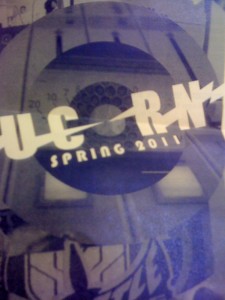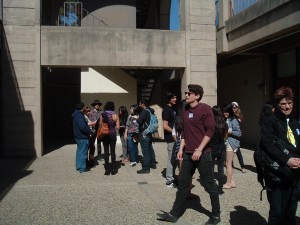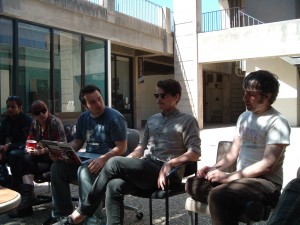Over the weekend I road-tripped to Santa Barbara for the University of California Radio Network’s (UCRN) spring conference. Held at University of California, Santa Barbara’s college radio station KCSB, the event brought together radio station advisors, staff members, and DJs from (for the most part) University of California-affiliated college radio stations. Held twice a year, the UCRN conferences (you can see my recaps from the spring 2010 and spring 2009 conferences on Spinning Indie) are an opportunity for stations to connect with each other and share skills and insights related to radio.
On Saturday, April 30, nearly 100 people from KCSB, KDVS (UC Davis), KALX (UC Berkeley), KZSC (UC Santa Cruz), KUCI (UC Irvine), UCLARadio.com (UCLA), KSDT (UC San Diego), Bobcat Radio (UC Merced) and KSPC (Pomona College, the sole non-UC member of UCRN) met for the all-day event. Only one station from the UC system, KUCR from UC Riverside, was unable to attend. Additionally, a few staff members from KCPR at Cal Poly San Luis Obispo were invited guests.
The conference (see the PDF of full schedule) had a communications rights focus to it this spring, so it fittingly kicked off with the keynote presentation, “College and Community Radio and Communication Rights,” by University of San Francisco Media Studies Professor Dorothy Kidd. In her talk, Dorothy outlined the ways in which college and community radio stations differ from commercial media. She argued that commercial media works to deliver audiences to advertisers, whereas community and college radio stations operate in the “vanguard” as places where DJs and programmers can still experiment. In discussing corporate consolidation in the radio industry, Dorothy said that stations have increasingly been “abdicating” their role to operate in the public interest. She reminded the audience that “the public owns the airwaves” and that licenses granted to stations by the FCC are merely “rental agreements.”
Dorothy praised college radio for stepping up in the aftermath of deregulation when the commercial industry “started to crash.” She emphasized the importance of radio’s potential as an “electronic public square” that is “fundamental to the practice of democracy.” Dorothy also spoke to not only first amendment rights, but also to communications rights worldwide, arguing the importance of being able to “produce and reproduce democracy and culture.” She said that radio is able to do this, but that both commercial radio and even public radio (NPR) have “abdicated their responsibility” to bring people together.
Having been involved with the fight to Save KUSF, Dorothy also made recommendations to the attending stations:
1. Recognize the value of your station and make sure your administration knows and appreciates your station
2. “If you’re not moving beyond your comfort level, you’re not doing a good job.”
3. Connect your station to specific “learning outcomes” on campus and if possible, have instructional time/professors teaching radio classes
4. Help to raise the profile of college and community radio by working with other stations and by reaching out to community groups, artists, musicians, citizen journalists, and politicians in order to talk about the “poaching” of the left side of the dial by radio groups and discuss the creation of a “third sector” of educational broadcasters.
Dorothy concluded her keynote by sharing a video of musician Ty Segall speaking about the opportunities he gained through his connections with college radio station KUSF. She also showed an animated video that summed up the fight to Save KUSF. Attendees who were concerned about the situation at KUSF were encouraged to write to the FCC opposing both the station sale to Classical Public Radio Network and the recently approved KUSF transmitter move. Dorothy also suggested that people demand that the FCC hold hearings about the future of college radio.
Following the keynote, a number of breakout sessions and workshops took place, with topics that included “Radio: An Accessible Form of Global Resistance,” “Music Directing in the Digital Age,” “Socially Aware Journalism,” “Re-examining Diversity in the Media,” “Interviewing Techniques,” and “Emergency Preparedness.”
College Radio as a Community Necessity
I sat in on the “College Radio as a Community Necessity” session, which served as a follow-up to Dorothy’s keynote. In the session we talked about ways to keep one’s station off of the chopping block.
Todd Urick from Common Frequency chimed in with some suggestions. He said that stations should ask themselves what they are doing for their home university and recommended that college radio stations form bonds within the university and build alliances with campus groups like the athletic department.
Todd also recommended that all stations have “proper professional and legal advice” and suggested that they build a non-profit with a “war chest” of funds available in case there is a fight over the station’s license. Todd also said that it would be great if college radio stations did a better job of communicating with the outside world by answering phone calls and emails. He also recommended that stations market themselves through their websites and multi-media. He said it would also be great if there was an easy way for community members to submit public service announcements and calendar listings, perhaps even through a station’s website. Todd pointed out that by engaging listeners and the community, a station is also building allies who will be helpful if the station’s future is ever in danger.
Erica Tyron, the Director/Advisor for KSPC, said that the Pomona College station does a lot to reach out to students on campus. They show up at campus events, throw concerts, and have held workshops and classes at KSPC on a number of topics including music journalism and turntablism. She said that it’s important to understand the values and mission statement of one’s school and “align yourself with that.” KSPC also helped to create the Youth Radio Project in conjunction with another campus department. Beyond that, they have formed connections with campus communications offices (they are part of the Claremont Colleges) and faculty members by offering up the KSPC studios for faculty members to use for media interviews with outside stations.
Similarly, KCSB programmer Tim Grigsby told me that when producing his public affairs show, he reaches out to faculty members for interviews. By monitoring campus press releases, he is able to stay on top of some of the interesting research being done at UC Santa Barbara and then contacts faculty members and graduate students in order to conduct interviews for his show.
Radio Outreach: Impactful Use of Marketing and Multimedia
I also sat in on a workshop about marketing one’s college radio station. The session participants talked about various ways that stations’ spread the word about their shows and events to both their campuses and to the surrounding community. Marketing ideas ranged from social media tools like Facebook, You Tube, and Twitter to traditional media like campus newspapers (KCPR’s schedule is included in their school paper every week), to more unusual ideas like bus ads (KCSB recently bought an ad that appeared on the outside of buses in Santa Barbara). Darla Bea Smith, who is a KCSB DJ and a marketing professional, suggested that stations have blogs, Facebook pages, Twitter accounts, and You Tube channels. She also recommended that individual DJs start Facebook pages and said that the station’s Facebook page should “fan” all of the DJ pages from the station. She said that it’s also a good idea to create a “vanity URL” for the station’s Facebook page (such as https://www.facebook.com/KCSB91.9 ), as that will make it show up in web searches more easily. Darla recommended that stations set up Facebook pages (rather than groups or individual pages) because there are more features available and multiple administrators can be assigned. She also suggested making use of tags on Facebook so that posts will show up on the walls of those being tagged (such as bands, other DJs, guests on shows, venues, etc.).
Students from UCLA’s online radio station UCLARadio.com talked about how they use a Google form to solicit sign-ups to their membership list. Their Facebook page even includes a link to “become a member,” which takes listeners to a sign up form. In addition to that, they have links directly from their Facebook page to their giveaway calendar, blog, You Tube page, and Donation page. The entire staff of UCLARadio is also encouraged to post Twitter updates about the station and post photos from concerts and events that they are covering.
Darla also recommended that stations think about logos and tag lines to ensure that they are in keeping with the station’s overall brand. The discussion also turned to the topic of street teams as a way to distribute program guides and stickers around campus and around town. The question was raised as to whether or not stations are played anywhere on campus or in the community, as that’s a great way to spread the word (and sound) to current and future listeners. In terms of multi-media, podcasts, videostreaming, and broadcast archives all came up as ways that stations utilize technology.
FM License Brainstorm Session
One of the most exciting sessions that I attended took place on Sunday morning. Todd Urick and Gavin Dahl from Common Frequency led a brainstorming session with staff and DJs from Bobcat Radio (UC Merced) and KSDT (UC San Diego) about various opportunities to obtain FM licenses. Staff and DJs from those two online-only stations were eager to learn how to move forward with these options and it was inspiring to see the creative ways that each station could get on the air.
Todd talked a little bit about Common Frequency and said that as a former Manager at KDVS he has an interest in college and community radio. He said that he noticed that while religious broadcasters were expanding and growing their networks, college and community radio stations were not. And with that, Common Frequency started with the mission to help college and community radio stations obtain frequencies on the radio dial.
As far as obtaining frequencies, Todd said that options include applying for a low power FM (LPFM) license when the new window opens within the next 2 years, acquiring a translator, or acquiring a full power FM or AM license. Both Todd and Gavin recommended that each station galvanize support from their campuse (from the administration to student groups) and surrounding community in advance of seeking funding for a terrestrial station. They also recommending that people thinking about starting up a radio station consider attending the National Federation for Community Broadcasters (NFCB) conference in San Francisco in June, think about going to the Grassroots Radio Coalition conference in Kansas City in August, and connect with Prometheus Radio Project, which is leading webinars on “How to Start a Low Power Radio Station” over the course of the next few weeks.
Thanks to everyone at UCRN and KCSB for welcoming me to their conference. In the weeks to come I’ll post a tour of KCSB on Spinning Indie.






